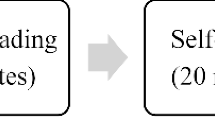Abstract
The purpose of this study is to experiment the usability of a speech recognition system to help deaf and hard-of-hearing students to understand the lesson inside the classroom by subtitling the speech of the professor in live. The proposed solution is to repeat the professor’s speech in a microphone plugged to a notebook with a speech-to-text software and to generate the text inside a collaborative editor displayed in front of the student. The repeater is a valid volunteer listening the professor’s speech in the classroom. The software transforms the voice in text. The deaf student could read the text on his own device (a notebook or a mobile device).
Access this chapter
Tax calculation will be finalised at checkout
Purchases are for personal use only
Preview
Unable to display preview. Download preview PDF.
Similar content being viewed by others
References
Antia, S.D., Jones, P.B., Reed, S., Kreimeyer, K.H.: Academic Status and Progress of Deaf and Hard-of-Hearing Students in General Education Classrooms. Journal of Deaf Studies and Deaf Education 14(3), 293–311 (2009)
Bochner, J.H., Walter, G.G.: Evaluating Deaf Students’ Readiness to Meet the English Language and Literacy Demands of Postsecondary Educational Programs. Journal of Deaf Studies and Deaf Education 10(3), 323–343 (2004)
Bouquillion, P., Matthews, J.T.: Le web collaboratif. In: Mutations des Industries de la Culture et de la Communication, p. 150, Presses Universitaires de Grenoble, Grenoble (2010)
Dell, N., Hutchin, J.: How and why Remote Captioning works for me. The Limping Chicken (May 9, 2013)
Dunlap, B.: Alternate methods of communication for the deaf & hearing impaired. Livestrong (October 6, 2010)
Long, G.L., Vignare, K., Rappold, R.P., Mallory, J.: Access to Communication for Deaf, Hard-of-Hearing and ESL Students in Blended Learning Courses. IRR ODL 8(3) (2007)
Luff, J.: Realtime speech translation will revolutionise how we communicate. WIRED (April 16, 2013)
Richardson, J.T.E., Marschark, M., Sarchet, T., Sapere, P.: Deaf and Hard-of-Hearing Students’ Experiences in Mainstream and Separate Postsecondary Education. Journal of Deaf Studies and Deaf Education 15(4), 358–382 (2010)
Schick, B., Williams, K., Kupermintz, H.: Look Who’s Being Left Behind: Educational Interpreters and Access to Education for Deaf and Hard-of-Hearing Students. Journal of Deaf Studies and Deaf Education 11, 3–18 (2006)
Author information
Authors and Affiliations
Editor information
Editors and Affiliations
Rights and permissions
Copyright information
© 2014 Springer International Publishing Switzerland
About this paper
Cite this paper
Lathière, B., Archambault, D. (2014). Improving Accessibility of Lectures for Deaf and Hard-of-Hearing Students Using a Speech Recognition System and a Real-Time Collaborative Editor. In: Miesenberger, K., Fels, D., Archambault, D., Peňáz, P., Zagler, W. (eds) Computers Helping People with Special Needs. ICCHP 2014. Lecture Notes in Computer Science, vol 8548. Springer, Cham. https://doi.org/10.1007/978-3-319-08599-9_73
Download citation
DOI: https://doi.org/10.1007/978-3-319-08599-9_73
Publisher Name: Springer, Cham
Print ISBN: 978-3-319-08598-2
Online ISBN: 978-3-319-08599-9
eBook Packages: Computer ScienceComputer Science (R0)




